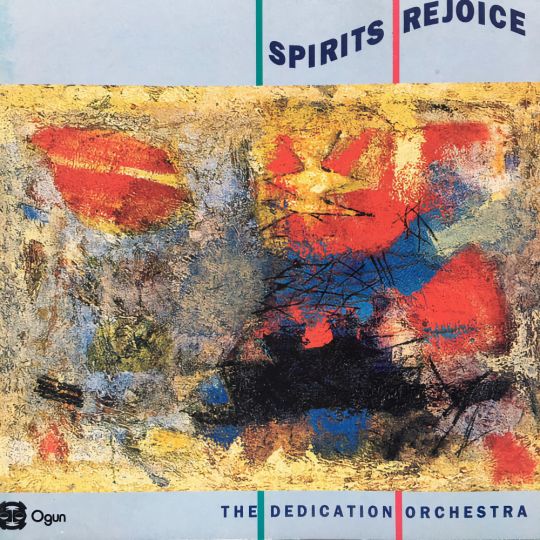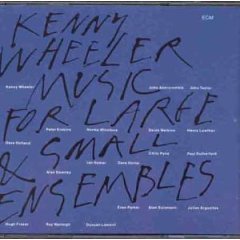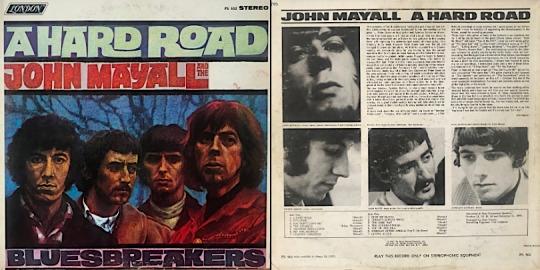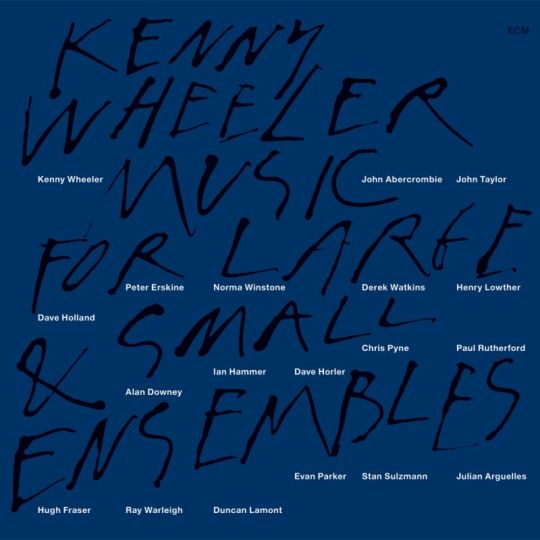#ray warleigh
Explore tagged Tumblr posts
Text

#dedication orchestra#spirits rejoice#you ain't gonna know me 'cause you think you know me#elton dean#ray warleigh#chris briscoe#paul rogers#louis moholo#neil metcalfe#django bates#keith tippett#lol coxhill#alan skidmore#evan parker#dave amis#malcolm griffiths#paul rutherford#radu malfatti#claude deppa#guy barker#harry beckett#jim dvorak#kenny wheeler#dave powell
9 notes
·
View notes
Text
Kenny Wheeler's Masterpiece: "Music for Large & Small Ensembles"
Introduction: In the realm of jazz composition, few names command as much respect and admiration as Kenny Wheeler. Released in 1990 by ECM Records, “Music for Large & Small Ensembles” stands as a monumental testament to Wheeler’s prowess as a trumpeter, flugelhorn player, and, above all, a brilliant composer. At its core lies “The Sweet Time Suite,” a composition of extraordinary depth and…

View On WordPress
#Anthony Braxton#Classic Albums#Dave Holland#Derek Watkins#Duncan Lamont#Evan Parker#Gil Evans#Henry Lowther#Jazz History#John Abercrombie#John Taylor#Julian Argüelles#Kenny Wheeler#Music for Large & Small Ensembles#Norma Winstone#Oliver Nelson#Peter Erskine#Ray Warleigh#Stan Sulzmann
0 notes
Text

Soft Machine – Bundles
Bundles is the eighth studio album by the jazz-rock band Soft Machine, released in 1975.
Soft Machine: Karl Jenkins – oboe, soprano saxophone, acoustic & electric piano Allan Holdsworth – electric, acoustic and 12-string guitars Mike Ratledge – Fender Rhodes electric piano, Lowrey Holiday Deluxe organ, EMS Synthi AKS synthesizer Roy Babbington – bass guitar John Marshall – drums, percussion Additional musician: Ray Warleigh – alto flute and bass flute on “The Floating World”
4 notes
·
View notes
Audio
Michael Giles (King Crimson alumni) - Title track of his album Progress
#progress#michael giles#1978#prog rock#geoff richardson#peter giles#ray warleigh#martin drover#pete thoms
2 notes
·
View notes
Photo

AllMusic Staff Pick: John Renbourn Sir John Alot of Merrie Englandes Musyk Thyng & ye Grene Knyghte
The guitarist teamed with Pentangle bandmate Terry Cox on percussion and jazzman Ray Warleigh on flute here. Issued in 1968, its first half is composed of traditional English folk, while the latter is devoted to jazz and blues. Highlights include solo guitar miniatures such as "Lady Goes to Church," the epic "Morgana," with its sharply nuanced tempo and timbre changes, and "My Dear Boy.” There’s also the bluesy "Transformation," for acoustic guitar and African drums; while the jazz-tinged “White Fishes," quotes from George Gershwin and Rodgers & Hammerstein, while "Sweet Potato," Chasnnels the Rolling Stones playing "Satisfaction" as an instrumental folk-rock song.
- Bruce Eder
3 notes
·
View notes
Audio
Ray Warleigh - Alto Saxophone Danny Thompson - Double Bass [String Bass] Terry Cox - Drums Alexis Korner - Electric Guitar Chris Pyne - Piano Written-By – W.C. Handy
11 notes
·
View notes
Photo


Nick Drake: Bryter Layter (1971)
Everyone’s least favorite Nick Drake album (pretty sure, anyway), Bryter Layter was released 50 years ago today (March 6) and stands apart from its more celebrated bookends (1969’s Five Leaves Left and ‘72’s Pink Moon) by virtue of its uniquely ornate production, spearheaded by Joe Boyd.
I just finished Joe’s fabulous memoirs of the enchanted 1960s, White Bicycles, (*) and I heartily recommend it to anyone who loves music AND quality prose; though I’ll caution you he spends less than 10% of the book on Drake, but when he does, his insights are second to none.
For it was Boyd who signed, mentored and produced the troubled troubadour, whose well-documented shyness and aversion to touring ultimately curbed his career prospects, and convinced Boyd to chuck the frill-free approach of Five Leaves Left for this, Nick’s second visit to the studio.
In fact, he seemed bent on breaking this often sullen, always insecure young man out of his shell, with help from a major names like Fairport Convention’s Richard Thompson (guitar on “Hazey Jane II”) and erstwhile Velvet Underground man John Cale (viola and assorted keys on the gorgeous “Fly” and “Northern Sky”).
Boyd also recruited pianist Chris McGregor and soulful backing singers to liven up “Poor Boy,” saxophonist Ray Warleigh for the haunting “At the Chime of a City Clock,” and veteran session pianist Paul Harris (Judy Collins, John Martyn, etc.) to for the album’s best-known cut, the gently rolling “One of these Things First.”
But, instead of lifting Drake’s spirits, Boyd suggests that atmospheric, string-and-or-flute laced instrumentals like “Sunday” and the title track (beautifully arranged by Robert Kirby) were Nick’s way of “stamping his foot” and conveying his dissatisfaction with the proceedings.
And yet, to hear if from Boyd, you’d think Bryter Layter was a pledge of love and confidence by the very people who admired Drake’s artistry (check out his fretboard dexterity “Hazey Jane I”) -- not that it mattered, since the album bombed anyway, just like its predecessor and successor.
The increasingly despondent singer eventually retreated to his parents’ home and died there of an accidental overdose in 1974, fated to widespread forgetfulness, if not for the unlikely, late ‘90s reappraisal of his works, spurred by, of all things, a Volkwagen commercial.
Now, half a century later, Bryter Layter does kind of sound like of a love letter TO Nick, from all his contemporaries -- Boyd included -- who tried to exert some positive inertia upon his highly elliptical orbit through the musical cosmos, bound straight for the Sun.
* During which his adventures included booking living room shows for rediscovered bluesmen like Lonnie Johnson, working the Newport Folk and Jazz Festivals, tour managing the likes of Muddy Waters, Sister Rosetta Tharpe and Coleman Hawkins, scouting the Paul Butterfield Blues Band, running London’s famous UFO Club, and producing neo-folk greats like The Incredible String Band, Fairport Convention and, of course, Drake.
More Nick Drake: Five Leaves Left, Pink Moon.
#Nick Drake#folk#folk rock#Fairport Convention#joe boyd#chris blackwell#vinyl#incredible string band#muddy waters#sister rosetta tharpe#coleman hawkins#newport jazz festival#bob dylan#the paul butterfield blues band#UFO club#paul butterfield#richard thompson#john cale#velvet underground#mike bloomfield
28 notes
·
View notes
Video
youtube
Annette Peacock – X-Dreams (1978 - Album)
Tracklist: [00:00] A1. My Mama Never Taught Me How To Cook Written-By – Annette Peacock [05:29] A2. Real & Defined Androgens Written-By – Annette Peacock [16:30] A3. Dear Bela Written-By – Annette Peacock [19:33] B1. This Feel Within Written-By – Annette Peacock [24:54] B2. Too Much In The Skies Written-By – Annette Peacock [29:49] B3. Don't Be Cruel Written-By – Elvis Presley, Otis Blackwell [34:25] B4. Questions Written-By – Annette Peacock
Credits: Bass – Jeff Clyne, Kuma Harada, Peter Pavli, Steve Cook, Stu Woods Congas – Brother James, Darryl Le Que Drums – Bill Bruford, Dave Sheen, John Halsey, Rick Morotta Engineer – John MacKenzie Burns Engineer [Assistant] – Andy Pearce Executive-Producer – Aaron Sixx Guitar – Brian Godding, Chris Spedding, Jim Mullen, Mick Ronson, Phil Lee, Tommy Cosgrave Keyboards – Peter Lemer Photography By – Bob Carlos-Clarke Producer, Vocals – Annette Peacock Saxophone – Dave Chambers, George Khan, Ray Warleigh
1 note
·
View note
Video
youtube
Progressive rock bands differed from one another during the 70's despite the cliche of all the groups of that idiom being fantasy oriented. For instance, Soft Machine mixed jazz and rock, which you can hear in the link. Moreover, they felt like a compendium of intriguing musicians within the style, since they housed Robert Wyatt, Kevin Ayers, Daevid Allen, Ray Warleigh and Karl Jenkins among others. That's why they kept changing, though their ethos remained the same. Unsurprisingly, their early records are valued more than their later ones, though that shouldn't shock us. Wyatt and Ayers, for instance, had such colourful temperaments that made those who had to replace them feel bland despite these substitutes not being such.
#soft machine#bundles#land of the bag snake#roy babbington#allan holdsworth#karl jenkins#john marshall#mike ratledge#70's music#progressive rock
1 note
·
View note
Photo

John Mayall and The Bluesbreakers- Hard Road
I suppose one of the cool things about the Hard Road album, which was recorded in October and November 1966 and released in February 1967, is that John Mayall has a lot to say in the liner notes. Since I really knew little or nothing about him, the other band members, not to mention the blues in general, it gave me some important early insights. Previously purchasing another ‘blues’ album by the American band The Blues Project, I hadn’t done more than enjoy listening to it, not actually getting much below the surface of what it was really about. By reading some of the insights and opinions of Mayall it helped lead me into to examining the blues in more depth in the future. In the case of Mayall it has been about the Chicago electric blues in particular, filtered through the British blues scene. He moved to, and has lived in, the United States since the end of the ‘60s.
My decision to obtain this album was directly due to one of my best friends in high school. We had met in our sophomore English class and started hanging out together fairly quickly. One of our favorite after-school pastimes was to head over to the record store in the shopping center across the street. We spent countless hours there listening to albums on record players with headphones attached. My friend had somewhat more eclectic music interests than me at that time. He made made a point that I listened to some of the blues albums there, this being one of them. At first I had to get used to the falsetto voice of John Mayall, but I was immediately intrigued by the guitar work of Peter Green. After a few listens I had become comfortable with the whole concept and finally decided to make the purchase.
At home I found myself listening to Hard Road more and more. At the time I was not that familiar with Eric Clapton, but was aware that he had been in The Yardbirds. After departing from them he was the guitarist on John Mayall’s Blues Breakers with Eric Clapton album. I think I had listened to that album a bit at the record store but it hadn’t really connected with me as this one had. Hard Road has become one of my favorite albums, there is not a song I don’t like, but of course there are some that I feel are outstanding. In addition to being the lead guitarist, Peter Green also was lead vocalist on two songs, wrote two songs - one of which, the instrumental Supernatural, is a truly impressive piece of work. Green also turns in some great playing on another instrumental, The Stumble. He does a nice job on You Don’t Love Me, which I soon found out is a true blues standard. As to John Mayall, he penned seven of the tunes on Hard Road, sang lead vocal in many of songs while playing guitars, organ, piano, and harmonica in various ones. In a user review of the album in Discogs, streetmouse mentions that Mayall had a preference for a 9-string guitar that allowed his guitar playing to sound “so eerie”. A seldom used type of intrument that the writer says van be breathtaking in the right hands. There was mention of various number string guitars in the liner notes, but this sheds some light on what was going on in some of album cuts. I enjoy what he does with Another Kinda Love, Someday After Awhile (You’ll Be Sorry), Living Alone, plus another blues standard, Dust My Blues. This album was even the core of a report I did in a music class I was taking in my junior year of high school.
Another talent that Mayall possesses is as an artist. He graduated from Manchester College of Art and first had a job as an art designer. Once he veered off and went the way of music he incorporated his talent into record album art, something which is in full display on the cover painting he created for Hard Road.
John Mayall went on to make many albums, jettisoning the Bluesbreakers name by the end of 1967, and then using it at times fifteen years later and beyond. This was the only Bluesbreakers album Peter Green and Aynsley Dunbar were on with him, and the last for John McVie. Ultimately those musicians went on to have substantial impact in other projects. Under the AllMusic review by Richie Unterberger a user review by Vinyl Connecrtion states that there were also three (unlisted) reed players who participated on some cuts on A Hard Road, John Almond, Alan Skidmore and Ray Warleigh. The user also suggests that Hughie Flint may have played drums in some capacity in the recording. The A Hard Road was third highest charting album by John Mayall, hitting No.8 on UK Albums chart. The other albums were Bare Wires at No.3 and Blue Breakers with Eric Clapton at No.8. There is no information as to whether it got onto any charts in the United States.
Mayall was another of those early on musicians for me, never expecting to necessarily ever see him live. He continued producing music and touring; ultimately I found myself seeing him perform solo on July 20, 2013 at the San Jose Fountain Blues Festival. We even got to say a brief hello to each other. At 86 years of age he is still touring but, as a footnote in history, he has had to take time off due to the COVID-19 virus. As of this writing it is unknown when he, and countless other folks, will be able to get back to what they were doing.
As for my high school friend who turned me onto John Mayall, we had lost contact after I had last seen him about thirty years ago. Last year changed that however. Thanks to a class alumni site we got ahold of each other and caught up on things. To my surprise he had decided to learn, and has been playing, guitar. His goal has been to play the blues. Play on, my friend.
https://en.wikipedia.org/wiki/John_Mayall
https://en.wikipedia.org/wiki/John_Mayall_%26_the_Bluesbreakers
https://en.wikipedia.org/wiki/A_Hard_Road
https://www.allmusic.com/artist/john-mayall-mn0000238495/biography
https://www.discogs.com/John-Mayall-And-The-Bluesbreakers-A-Hard-Road/master/30189
https://www.udiscovermusic.com/stories/rediscover-john-mayall-a-hard-road/
https://needlemeetsvinyl.com/products/john-mayall-the-bluesbreakers-a-hard-road-1967-ex-vg?variant=29676963856483
A Hard Road full album https://www.youtube.com/playlist?list=PL8a8cutYP7foja1vHkWcUfkaT9m1Huwdx
LP27
0 notes
Text

4 notes
·
View notes
Photo

Nel 1999 la Volkswagen decise per la prima volta di attuare una campagna solo per Internet, con un film spot della Golf Cabrio. Come colonna sonora scelse una canzone solo chitarra e voce semi sconosciuta, che fece la fortuna del suo autore, che in breve tempo ottenne successo e vendite mai registrati. L’unico problema è che quella canzone, Pink Moon, Nick Drake la incise nel 1972, e lo stesso Drake era morto all’epoca da 25 anni. Nick Drake nasce in Birmania, dove il papà fa il militare. Cresce in una famiglia anticonvenzionale, legato all’amore per le arti e alla natura. Si iscrive al prestigioso Fitzwilliam College dell'Università di Cambridge, dove si laurea in letteratura inglese. Durante un concerto per la pace viene notato da Ashley Hutchings, bassista dei Fairport Convention, attratto da quel tipo smilzo, dalla voce calda ed espressiva, ma così poco appariscente. Lo segnala a Joe Boyd, uno dei più grandi scopritori di talenti della musica inglese, a cui dobbiamo i Pink Floyd, e buona parte dei grandi gruppi del folk rock inglese di quel periodo. Boyd produce le prime idee musicali di Drake, che verranno pubblicate nel bellissimo Five Leaves Left (1969). Con l’apporto strumentale di Richard Thompson alla chitarra e Danny Thompson al contrabbasso, il disco sfodera dolci e melanconiche melodie, orchestrate dagli archi di Robert Kirby: piccoli acquarelli musicali le splendide Time Has Told Me, River Man, la malinconica The Thoughts Of Mary Jane e riferimenti esotici in Three Hours. Le vendite e il successo sono bassi, anche perchè Drake ha una maniacale paura di suonare in pubblico, un timore che quando riesce a superarlo, regala esibizioni stupende, come in un live a tre con i Fairport Convention e il suo amico John Martyn al Festival Hall di Londra nel 1970. Nello 1971 pubblica il disco di oggi, sempre sotto l’egida di Boyd. Bryter Later è, a mio parere, il suo disco musicalmente più bello e riuscito. Il titolo è un gioco di parole che foneticamente riprende l’espressione brighter later, che in senso meteo vuol dire a seguire schiarite. Quasi una prospettiva per il taciturno e introverso Drake, che nel disco è spumeggiante. Accompagnato da una squadra strumentale da favola, oltre ai due Thompson di sopra, Dave Mattacks e l’ex Beach Boys Mike Kowalski alla batteria ma soprattutto John Cale (Piano, Celeste, Organo, Clavicembalo) il disco ha una piccola Introduction strumentale, per poi virare nel brioso pop di Hazey Jane II, che passa il testimone alla jazzata e meravigliosa At The Chime Of A City Clock, con spettacolare tappeto sonoro di sax (di Ray Warleigh); One Of These Things First è un brano dominato dal duetto piano e voce di Drake, che acquista qui uno spessore particolare, Hazey Jane I è puro folk british del periodo. Bryter Later è il secondo toccante strumentale, prima della splendida Fly : il connubio fra voce e chitarra di Nick Drake ed il clavicembalo suonato da Cale è semplicemente imperdibile, oltre che commovente. Chiudono il capolavoro Poor Boy, lo strumentale Sunday con fiati ed archi e la meravigliosa Northern Sky, dove Cale suona piano, celeste ed organo, con uno dei testi più intensi e pregnanti di Drake. Sebbene il disco sia un gioiello, le vendite sono ancora molto basse. Drake ne sente molto il peso e inizia ad accusare gravi problemi psicologici. Si trasferisce per un po’ in Spagna, invitato dal nuovo produttore Chris Blackwell. Ripresosi, registra in due sole notte, solo con la chitarra, Pink Moon (1974), dolente e magnifico testamento psicologico e musicale, con canzoni mito come la title track, Place To Be, Know, con un’atmosfera dolente ed esotica, magnetica e cupa, che non avrà più epigoni. Parte per Parigi, dove ha in mente un disco con Francoise Hardy, ma non se ne fa nulla. È sempre più triste e malato. Nel 1974, il 25 novembre, viene trovato morto per overdose di Tryptizol, e secondo il racconto della madre che poverina lo trovò, sul piatto del giradischi giravano i Concerti Branderburghesi di Bach e sul comodino Il Mito di Sisifo di Camus. Se ne va così uno dei più grandi cantautori inglesi, sicuramente il più sottovalutato e misterioso, mito tardivo e tutto da scoprire.
P.S. per chi è curioso, il video dello spot è questo
18 notes
·
View notes
Photo

#nowplaying #NickDrake #eponymous #1971 #IslandRecords #digitalaudio listening through #JRiverMediaCenter21 • Nick Drake was an American only LP compilation release by Nick Drake. It was released in August 1971 as SMAS-9307, shortly after Island Records had started selling their own records in the U.S. At the time, they were distributed by Capitol records. The album included three songs from Five Leaves Left and five songs from Bryter Layter, and was packaged in a gate-fold sleeve that featured photos by Keith Morris. • Personnel[edit] Nick Drake – vocals, guitar, piano Rocky Dzidzornu – percussion Mike Kowalski – drums Clare Lowther – cello Dave Pegg – bass Danny Thompson – bass Ed Carter - bass Chris McGregor – piano John Cale - piano, celeste, organ, harpsichord, viola Paul Harris - piano Ray Warleigh – alto sax P.P. Arnold and Doris Troy – backing vocals Robert Kirby - string arrangements Harry Robinson - string arrangements Production notes: Joe Boyd – producer John Wood – engineer
1 note
·
View note
Audio
Paz - Paz Are Back - 1982 jazz-funk reissue from BBE Music
Alto Saxophone, Soprano Saxophone, Flute, Panpipes – Ray Warleigh Bass, Double Bass – Ron Mathewson Drums – Frank Gibson Guitar – Ed Speight Percussion – Chris Fletcher, Simon Morton Piano, Electric Piano, Synthesizer – Geoff Castle Timbales – Martin Drew
4 notes
·
View notes
Text
Music for Large & Small Ensembles

Kenny Wheeler
🎧 https://www.youtube.com/playlist?list=OLAK5uy_kFsTvFe7RCScvlb6VYqxocUAUrAYgEX74
Music for Large & Small Ensembles is an album by Canadian jazz trumpeter Kenny Wheeler which was released in 1990 by ECM Records.
Kenny Wheeler – trumpet, flugelhorn Norma Winstone – vocals Evan Parker – soprano & tenor saxophone Ray Warleigh – alto saxophone Stan Sulzmann – tenor saxophone, flute Duncan Lamont – tenor saxophone Julian Argüelles – baritone saxophone Derek Watkins – trumpet Henry Lowther - trumpet Alan Downey – trumpet Ian Hamer – trumpet David Horler – trombone Chris Pyne – trombone Paul Rutherford – trombone Hugh Fraser – trombone John Taylor – piano John Abercrombie – guitar Dave Holland – double bass Peter Erskine – drums Jan Erik Kongshaug – engineer
0 notes
Video
youtube
John Renbourn - The Lady And The Unicorn (Full Album) atravesdelrio 01. Trotto / Saltarello 02. Lamento Di Tristan / La Rotta 03. Veri Floris / Triple Ballade 04. Bransle Gay / Bransle De Bourgogne 05. Alman / Melancholy Galliard 06. Sarabande 07. The Lady And The Unicorn 08. My Johnny Was A Shoemaker / Westron Wynde / Scarborough Fair John Renbourn: guitars and sitar Terry Cox: hand-drums and glockenspiel Don Harper: viola Lea Nicholson: concertina Tony Roberts: flute Ray Warleigh: flute Dave Swarbrick: violin
0 notes